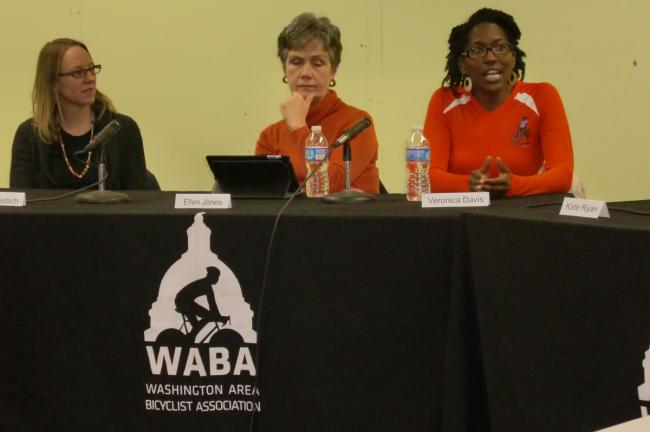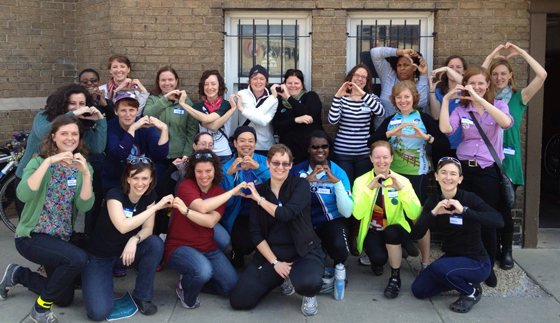DISCOVER YOUR LOCAL BICYCLING COMMUNITY
Find local advocacy groups, bike shops, instructors, clubs, classes and more!
Webinar Recap: 10 Tips for Women’s Bicycling Forums
What’s the first step to encouraging more women to ride? Starting the conversation! In a growing number of communities, organizations and individual leaders are using Women’s Forums to kick off the discussion — and start building campaigns. On our Women Bike webinar yesterday, we heard from leaders who have organized successful local and state forums in Chicago, Ohio and D.C., and shared important inspiration and lessons learned that you can use in your community.
 Jess Mathews (right) with Ohio First Lady, Karen Kasich, at the Ohio Women’s Bicycling Summit this May
Jess Mathews (right) with Ohio First Lady, Karen Kasich, at the Ohio Women’s Bicycling Summit this May
Click here to download the slides — video coming soon!
Here are my top 10 take-aways from the lively discussion:
1) No staff? No budget? No problem! In the Windy City, Women Bike Chicago was established by a group of women with ties to the larger bike community — but a desire to create something specifically for female riders and potential bicyclists. Describing themselves as “a loosely organized, grassroots federation of women in Chicago from every organization and none,” they put together a successful “Day of Dialogue and Demos” with all donated space, materials and volunteer time.
 Women Bike Chicago is all-volunteer, including Susan Levin (right)
Women Bike Chicago is all-volunteer, including Susan Levin (right)
2) From the start, know your goal: For the Washington Area Bicyclist Association, the women’s forum in late 2011 had a clear objective: Get input from bicyclists and female leaders to create the buy-in and foundation for a potential advocacy initiative to engage more women. So having a room filled with current cyclists — rather than potential riders or the “interested but concerned” crowd — was exactly what they needed. On the other hand, the Ohio Women’s Bicycling Summit aimed to engage the full spectrum of novice to veteran riders and created a very broad program to get as many women in the door.

Local bicycling leaders, including Veronica Davis, co-founder of Black Women Bike DC
3) Think about synergy: For Jess Mathews, the Ohio Women’s Bicycling Summit became a reality because she knew that women’s rides weren’t just taking off in Columbus, but in Cleveland, as well. Understanding the landscape and doubling down on the already present momentum made a statewide event possible.
4) Grab the low-hanging fruit, but reach beyond you inner circle: Because the community responded quickly and enthusiastically to the Women Bike Chicago event, the RSVPs rapidly hit the event capacity — without time for outreach to women who don’t ride or diverse bicycling communities. If they could do it over again, Susan Levin said, they would have allocated more time and strategy to get their posters up in cafes and daycare centers — places where they might have captured the attention of bike-curious ladies who weren’t yet riding or not part of the larger bicycilng community.
5) Keep it simple: Especially with your first event, don’t go overboard. For the Ohio Summit, the organizers stuck to a manageable agenda, even when they came up with cool ideas— that might be tough to execute. Better to host a small but solid event to get folks engaged than go big — and fall flat.
6) With mulitple sessions, you can’t be too organized: Women Bike Chicago had the great idea to have an outdoor demo area at their event, where women could try out different types of rides, like bakfiets to transport kids and new Divvy bike share bikes. It was a well-received, but needed more explicit time management on the part of the organizers to wrangle the crowd and keep the event on track. This was also true of placing signage and managing volunteers — no detail is too small to plan when you’ve got multiple moving piece in your event puzzle.
7) Consider a women’s outreach internship position: For the Washington Area BIcyclist Association, the women’s forum (and everything that came out of it) was the result of a volunteer Women’s Outreach Internship. Thanks to intern, Jesse Cohn, the organization was able to start the wheels turning toward a program aimed at women that was well-researched and informed by local leaders and riders. With very little oversight from WABA staff, the internship added the capacity they needed to make Women & Bicycles a reality.
Jesse Cohn, center, kicked off WABA’s women’s initiative by gathering input and organizing the first forum
8) Use your Forum to create momentum and support: WABA made sure their Women’s Forum reached beyond the 80 people who packed the room that one night. They blogged about it before and after; reached out to media to cover the event / topic; and live Tweeted great quotes as they happened during the discussion. That buzz, combined with the content of the discussion, helped WABA’s staff, board and members to come to agreement: We have a problem and we need to fix it.
9) Leverage your event for bigger, sustained efforts: For WABA, the two-hour forum in late 2011, turned into a fully funded, full-scale, incredibly successful Women & Bicycles program in 2013. For Women Bike Chicago, their event sparked dialogue with the larger, long-standing, local bicycle advocacy organization, Active Transportation Alliance. For the Ohio Women’s Bicycling Summit, the success of the event and participation of women from other states sparked the idea of a Midwest Summit.
 WABA’s Forum was the first step to a full-fledged Women & Bicycles advocacy campaign
WABA’s Forum was the first step to a full-fledged Women & Bicycles advocacy campaign
10) Ask for feedback: All the organizers created surveys for their participants so they could create better events or programming to meet the needs of local riders — and potential riders — in the future.
Click here download the slides and stay tuned for the full video.
Also, read past Women Bike blogs about these leaders and Women’s Forums below…